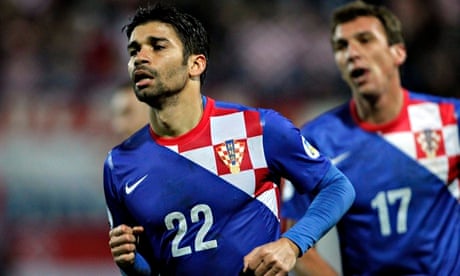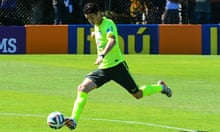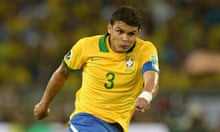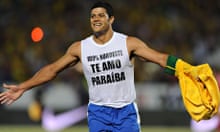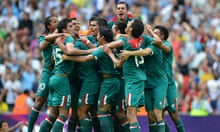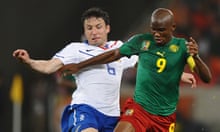This article is part of the Guardian's World Cup 2014 Experts' Network, a co-operation between 32 of the best media organisations from the countries who have qualified for the finals in Brazil. theguardian.com is running previews from four countries each day in the run-up to the tournament kicking off on 12 June.
Gone are the days of relentless tactical experiments which ultimately saw Igor Stimac fired before November's World Cup play-off with Iceland. Unlike his massively unpopular predecessor, Croatia's new manager, Niko Kovac, is adamant to play "4-2-3-1-come-4-1-4-1" as he proclaimed right from the start of his tenure. That formation may bring the best out of Luka Modric and Ivan Rakitic, the team's playmaking duo, but it still does not solve either of the two old issues: the shortage of quality wingers and the need to balance creativity with a physical presence in midfield.
Despite Danijel Subasic doing really well at Monaco, the 35-year-old Stipe Pletikosa is still the first-choice goalkeeper. Reliable rather than spectacular, he has held that post for almost 15 years. The captain Darijo Srna, of Shakhtar Donetsk, is the undisputed right-back, while Lokomotiv Moscow's Vedran Corluka and Southampton's Dejan Lovren should make the centre-back pairing. Left-back has been a permanent weak spot, which is why Kovac called back the almost forgotten Danijel Pranjic, now at Panathinaikos. And with Dnipro's Ivan Strinic injured that position should go to Pranjic.
Real Madrid's Modric and Sevilla's Rakitic will be expected to run the show in the central area. But a place for Mateo Kovacic, Internazionale's rising star, also needs to be found and the question is – where? It is the same dilemma that Miroslav Blazevic had as the manager of the 1998 bronze-winning generation featuring Zvonimir Boban, Robert Prosinecki and Aljosa Asanovic: fielding all three midfield playmakers is just as risky as it is tempting.
Though the current trio are all tactically intelligent and apt as ball-winners, they do not offer enough "muscle"; besides that, too much focus on defensive work could stifle their creativity. Adding a holding specialist – like the experienced, but often doubted Ognjen Vukojevic of Dynamo Kiev – is the safer option. In that case, young Kovacic could be deployed to one of the wings, which should suit him much more than was the case with Rakitic, who had previously been routinely (mis)used in wide positions for the national team.
That particular switch is among the things Kovac is considering for the tournament opener against Brazil on 12 June, when his star striker Mario Mandzukic won't be available due to suspension following his red card in the 2-0 second leg play-off victory over Iceland.
The Bayern Munich player will be replaced by either Eduardo (Shakhtar Donetsk) or by the veteran Ivica Olic (Wolfsburg) – the latter has often been utilised out wide for Croatia, mainly out of necessity, but is more natural up front. Olic's club team-mate Ivan Perisic is expected to start on the other flank.
It's also worth noting that almost all of the players mentioned have a very good club season behind them and several enjoyed a late upsurge in form. They should be at their peak come the World Cup.
Who is the player who is going to surprise everyone at the World Cup?
In a team packed with experience, the wonderfully gifted Mateo Kovacic is at least five years younger than any other starter. And yet his role could be key to dealing with Croatia's shortcomings. The 20-year-old had arguably been neglected by Internazionale's coach Walter Mazzari before he finally began to flourish late in the season – culminating with an incredible performance in Javier Zanetti's farewell game at San Siro, when he sliced open the Lazio defence with three assists in a 4-1 win.
Kovacic is a very technically skilled and explosive player, a great dribbler with an exceptional vision of the game, which means both that he's able to make crucial interceptions defensively and provide key passes to attackers. But he's rather weak in the air and not nearly as compact a player as Modric – rather than shielding the ball and keeping it moving with many short passes, he needs space.
Kovacic enjoys dropping deep to get the ball and then driving it forward with pace. With his light feet and impressive acceleration with the ball, he is perhaps better suited for one of the positions behind the striker (either central or wide) in Croatia's 4-2-3-1 than to that of a deep-lying playmaker. How exactly Kovac will decide to use him is still to be seen, but the youngster could be a true revelation at the tournament.
Who is the player who is going to disappoint the most?
Dejan Lovren won many admirers in England during his debut Premier League season, but he has never really excelled for the national team. That is the main reason he is still somewhat underrated in his homeland. The World Cup is the best opportunity for him to prove his worth and Croatia fans will certainly expect him to do so.
However, there's one particular aspect of Lovren's game his fellow countrymen dread could come into focus – and that's his less-than-great disciplinary record. He tends to get careless every now and then and concede unnecessary fouls in the danger zone. Croatia will almost certainly play with a deeper defensive line than Southampton do and officiating at the World Cup could well be stricter than it is in England, so any lapses of concentration could prove very costly. Hopefully not many of them will happen, though. Croatians need to learn to trust Lovren more.
What is the realistic aim for your team at the World Cup and why?
Given the size of our population, the standard of our domestic league and everything we've been put through in the qualifiers, qualification alone is a great achievement in itself. But it's also true that we have a potent and experienced team, with key players at their individual peak. Neither Mexico nor Cameroon are better than us and we can give Brazil at least a good run for their money. So progressing from the group stage, for the first time since 1998, is a realistic aim. And after that … well, anything can happen in those knockout rounds, right?
Aleksandar Holiga writes for Croatian website T-portal
